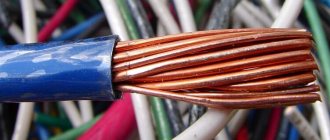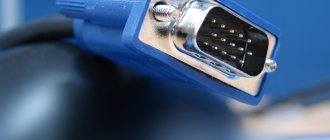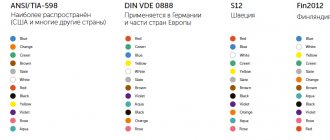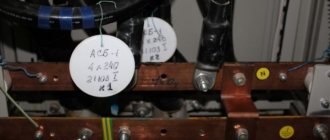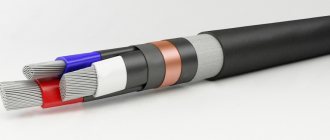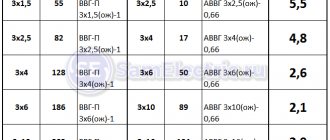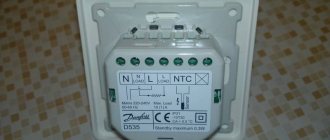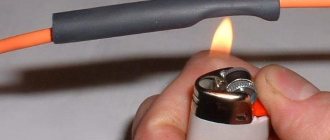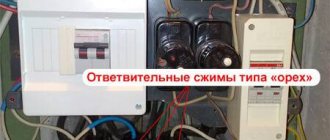The modern industry producing electrical products is ready to offer consumers a huge assortment of cable products. Each type of electrical cable or type of wire is used to solve a specific professional task of electrifying a facility. Any person who decides to install electrical wiring on a personal summer cottage, in his own city apartment or private house will soon understand that copper conductors are most often used for such work and aluminum conductors are much less often used. There are simply no other options, although there are quite a lot of metals with low current resistance.
Why copper and aluminum? Yes, everything is very simple! These are the cheapest non-ferrous metals, optimally suited for the production of wires due to their technical and design characteristics. Of course, it is quite possible to make a cable from gold, but the price of this product will be prohibitive!
Cable products and wires for installation of electrical wiring in residential and other facilities are divided into several types and types: powerful power cables, special self-supporting cables, electrical wires for hidden and open wiring, installation conductors, and so on.
The range of basic characteristics of such electrical products is varied. All cable electrical products are divided into categories not only according to their purpose, but also according to the type of insulating layer, the structure of current-carrying conductors and the metal from which they are made, design features and other parameters. This article will discuss the main types and types, technical parameters and other characteristics of electrical wires and cables that are used when installing electrical wiring and connecting private houses, apartments, cottages and other real estate to power networks.
Attention! Choosing the right electrical cable or wire is a very responsible matter, on which the safety of your property and your own health depends. Therefore, for those who do not want to face such catastrophic events as a short circuit, fire or electric shock, we recommend that you carefully select electrical products that meet the requirements of the Electrical Installation Code (PEU).
Basic Concepts
The characteristics of any cable or wire are determined by the properties of its conductors and the insulation surrounding them.
Lived in the electrical wiring
Residential wire is a wire made of metal that can pass electric current through itself. It has two important characteristics - the number of wires of which it consists, and the cross-section, which determines the throughput.
Based on the number of wires, the cores are divided into single-wire (monolithic) and multi-wire. This parameter determines the flexibility of the core - the more wires it contains, the easier it bends. You need to pay attention to this when choosing a wire or cable for certain purposes - if the installation of electrical wiring in the walls can be done with single-wire conductors, then to replace the power cord of an electrical appliance you need to take wires with multi-wire conductors. There is no insulation between the individual wires of a stranded core - usually they are simply twisted together.
Single-wire core.
Multi-wire core.
The cross-sectional area of the conductors determines the total current power that can be passed through it. Since the wire cross-section is the main parameter used in calculating the electrical wiring capacity, manufacturers are required to indicate it on the conductor insulation. To avoid confusion, this is done at regular intervals - usually up to 1 meter, and if the wire is bare, then the cross-section is indicated on the packaging of the coil, but it is advisable to double-check it with a caliper or micrometer. You also need to be careful when buying inexpensive brands of wires - GOST provides certain tolerances for the thickness of conductor cores and sometimes manufacturers actively take advantage of this. For example, there are brands of wires with a tolerance of as much as 30%, and if the accuracy of the equipment allows, then instead of 1 mm² you can get cores with a cross-section of 0.75-0.8 mm² and everything will be within the law.
There are also differences in the shape of the cores - they are mostly round, but in a number of types of wires and cables they are made, for example, sector - single and multi-core. This improves the overall core layout and reduces the outer diameter of the entire product.
Electrical wiring insulation
The main task of the insulating dielectric layer is to protect a person from contact with a live conductor. Also, the presence of insulation allows you to place several cores side by side without fear of a short circuit between phase and zero (contact of the phase conductor with the ground) or other phases.
For various purposes, certain dielectrics are used: ceramic or glass, and for flexible cables and wires, polymer ones - polyvinyl chloride or celluloid. For household wiring, polymer insulation is most often used - its properties allow not only to protect the conductors from short circuits, but also to protect them from mechanical damage, high humidity and other external factors.
Armored wires and cables are also manufactured, with multilayer insulation, inside of which there is an additional braid or steel tape. They are used on unstable soils, when laying lines under roads and in similar conditions.
For outdoor installation
Underground supply to the building is made only with the help of armored electrical cables AVBBSHV or VBBSHV. The steel armor tape on such electrical cables passes over the second insulating layer and has its own protection - a rubber coating. Such protection of current-carrying elements from groundwater and mechanical influences ensures the durability and reliability of the electrical supply.
For installation of external electrical wiring on street-side walls or roofs, the optimal types of wires/cables are AVVG or VVG. These brands have excellent insulation that can withstand low and high temperatures and ultraviolet radiation.
What are the differences between cable and wire
The same conductors of electricity can be called a cable, wire or cord. At the same time, to be honest, both buyers and some sellers do not particularly bother themselves with the correct wording.
Wire is the basis
By definition, a wire is one or more current-carrying conductors that connect two sections of an electrical circuit. The cores can be single or multi-wire, bare or insulated and differ in other characteristics. There is also a separate category of protected wires that can easily be confused with a cable, due to the presence of an outer sheath - each core has its own insulation, and all together on the outside are additionally covered with a cambric made of polymers or similar materials.
Bare wires are practically not used in everyday life - they are more often used to transmit electricity over overhead lines and in other places where a person cannot go without permission.
Insulated wires themselves are rarely used in everyday life - they are mostly used inside various electrical equipment or in the electrical network of an electric vehicle.
Cable - prefabricated structure
The structure of the cable is similar to a protected wire - it is one or more current-carrying wires, each of which has its own insulation, plus another insulating and protective outer layer made of polymers, plastic or rubber.
The main difference between a cable and a wire must be looked for inside - if the latter has an outer sheath that is just a tube, then the cable additionally fills the space between the current-carrying conductors - threads, tapes or a coated compound. This prevents the cores from sticking together, which may move slightly relative to each other when the cable is bent, which simplifies its installation and further maintenance.
Additionally, armored cables stand out - they have several layers of outer insulation, between which there is protection from mechanical damage in the form of braiding or intertwined metal tapes.
Cord - flexibility
The main use of electrical cords is connecting household electrical appliances to the network. They must have increased flexibility and resistance to repeated bending, so the cords use copper stranded conductors with a total cross-section of up to 4 mm².
To avoid excessive consumption of copper during the production of devices, the cross-section of the cords is selected depending on the power of the connected devices. For small electrical appliances, like an electric razor, it will be 0.35 mm², for televisions 0.5 mm² is enough, and for devices with an electric motor - from 0.75 mm².
There are no strict standards for the length of cords, but most often they are 1, 1.5, 2, 3.5, 4 and 6 meters. Electrical appliances are often equipped with cords with non-removable (disposable) plugs, and for some devices reinforcement is woven under the outer insulation to increase mechanical strength. If you have to change the electrical cord on a device with heating elements: an iron, boiler, kettle or electric stove, you must take into account that the insulation must be of increased heat resistance.
As a result - the main differences
An independent and separate unit is a wire - bare or insulated. Several insulated wires collected in a bundle and twisted together are also wire, but multi-core. If there is additional insulation on top of a stranded wire, then it is a protected wire.
If there are additional elements between the cores of a protected wire: reinforcing threads, coating, or part of the outer sheath is “recessed” between the wires, then this is already a cable. A flexible wire or cable made to connect electrical appliances is called a cord.
How to choose electrically conductive products
To choose the right current-carrying conductor when laying household electrical networks, you must adhere to the following recommendations:
- The wire or cable must be three-core. This is necessary for grounding. If it is not yet in the house, the yellow-green core is simply isolated and not connected.
- The conductor material is copper. PEU rules prohibit the use of aluminum wiring in everyday life.
- Before choosing a cable cross-section, it is necessary to determine the total load to which it will be subjected. For lighting, a copper conductor cross-section of 1.5 mm² is sufficient, and for sockets - 2.5 mm². To connect powerful household appliances, the wiring cross-section must be at least 4 mm².
- Brand. It depends on the conditions in which the electrical wiring will operate: indoors or outdoors, with high humidity, etc.
- Manufacturer. There are many fakes, so it is better to buy products from trusted brands.
There is a wide range of such products on the market. Knowing in what conditions and under what loads the conductor will operate, and being able to decipher the markings, you can independently select the desired cable or wire.
The difference between cables and wires depending on the core material
Cores of wires and cables for specialized purposes can be made of various metals, but aluminum and copper are mainly used in electrical engineering. Each of them has its own specific properties, advantages and disadvantages, which must be taken into account when selecting a core material for a specific purpose.
Aluminum conductors
The invention of a relatively inexpensive method for extracting aluminum made a revolution in the global development of electrification, because in terms of electrical conductivity this metal ranks fourth, behind only silver, copper and gold. This made it possible to reduce the cost of production of wires and cables as much as possible and make universal electrification a reality.
Such electrical wires and their types are distinguished by their low cost, chemical resistance, high level of heat transfer and low weight - they have determined the mass of electrification in industrial and domestic conditions for more than half a century.
In light of the relatively recent dominance of aluminum in the wire market, it may seem strange to the uninitiated that the provisions of the PUE prohibit the use of this material in everyday life. More precisely, you cannot use aluminum wires with a cross-section of less than 16 mm², and these are the most common of them for installing home electrical wiring. To understand why there is a ban on the use of these wires, you can familiarize yourself with their advantages and disadvantages.
+ Advantages of aluminum wires
- Lighter than copper.
- Significantly cheaper.
— Disadvantages of aluminum wires
- Aluminum conductors with a cross-section of up to 16 mm² can only be single-wire, which means they can only be used for laying stationary wiring and without bending at an acute angle. All flexible wires and cables have always been made of copper.
- The chemical resistance of aluminum is determined by the oxide film that forms when it comes into contact with air. Over time, with constant heating of the contact due to the flow of electric current through it, this film deteriorates electrical conductivity, the contact overheats and fails. That is, aluminum wires require additional maintenance, and the contacts through which powerful currents pass are coated with a special lubricant.
- Amorphous material - if you clamp two aluminum wires together, the contact will weaken over time, as the aluminum will partially “leak out” from under pressure.
- Soldering can only be carried out using special tools, and welding can be performed in a chamber with an inert gas.
- Good electrical conductivity is observed only in pure aluminum, and impurities inevitably remaining during production worsen this indicator.
As a result, aluminum is a good choice if you need to save money here and now, but in the long run its use will be more expensive due to its relatively short service life and the need for regular maintenance. For this reason and additional safety reasons, the PUE strictly prohibits using it for laying new power lines.
Copper conductors
In terms of electrical conductivity, copper is in second place, only 5% inferior to silver in this indicator.
Compared to aluminum, copper has only 2 significant disadvantages, due to which for a long time it was used much less frequently. Otherwise, copper wins in all respects.
+ Pros of copper wires
- Electrical conductivity is 1.7 times higher than aluminum - a smaller cross-section of wire will pass the same amount of current.
- High flexibility and elasticity - even single-core wires can withstand a large number of deformations, and multi-core wires make cords for electrical appliances with increased flexibility.
- Soldering, tinning and welding are carried out without the use of additional materials.
— Disadvantages of copper wires
- The cost is several times more expensive than aluminum.
- High density - a coil of copper wire, the same length and cross-section as aluminum, will weigh 3 times more.
- Copper wires and contacts oxidize in open air. However, this practically does not affect the contact resistance and, if necessary, is “treated” by lubricating the surface of the already tightened contact.
As a result, although copper is a more expensive material, in general its use is more economical, since it is more durable, requires less effort during installation and attention during maintenance.
Cable product structure and purpose
The characteristics and structure of the cable product are determined by its purpose. Its classic structure is:
- core (single or multi-wire);
- core insulation;
- cable insulation.
Most often, the cores have a round cross-section, but there are also square and oval ones. They are made of aluminum or copper, sometimes steel. The cross-sectional size of the core determines its throughput.
Multi-core cables are more flexible than single-core cables.
Difference between cables and wires depending on insulation
In a cable or protected wire, the insulation is divided into internal, covering each core separately, and external (outer). The first protects the cores from contact with each other and ensures their protection from mechanical damage. The outer one holds all the components of the cable together and additionally protects the internal insulation from drying out, high humidity and other factors.
Insulation characteristics
When selecting insulation, its ability to withstand:
Voltage . In domestic conditions, special attention is not paid to this issue, since the vast majority of materials can withstand up to 660 or 1000 Volts.
High temperature . When current passes through a conductor, part of the energy is dissipated in the form of heat, which is dissipated from the insulation surface into the environment - the air, if it is open wiring, or goes into the walls, if closed. At a certain point, equilibrium occurs when the amount of heat released is compared with the heat given off. The temperature that is set at this moment must be in the range of the so-called operating temperature, which the wire insulation must withstand indefinitely. For short-term overloads, there is also a temperature limit that the insulation must withstand for a certain time without consequences. The behavior of the insulation when overheated is also indicated - combustion, smoldering, release of substances harmful to humans into the air, and others.
Low temperature . If the cable will be used outdoors, then you need to additionally look at the frost resistance indicator - at a certain subzero temperature the insulation becomes fragile, which must be taken into account during installation and further operation.
Ultraviolet resistance . Some insulating materials, despite other excellent characteristics, begin to deteriorate over time if exposed to sunlight. They become brittle and shrink - this must be taken into account if, for example, you plan to install wiring to a veranda or summer house.
Mechanical tensile strength . The more, the better, although, of course, there is no point in taking a heavy-duty cable to repair the wire of a light bulb.
Insulation materials
A large number of insulating materials are used in electrical engineering; even just listing them all is quite difficult. But at the household level, it is enough to know those of them that are used most often - for internal electrical wiring and supplying electricity to the house.
Polyvinyl chloride (PVC).
Due to its low cost and good physical characteristics - flexibility and wear resistance, it is most often used for insulating wires that are laid indoors. Non-flammable and quite resistant to aggressive chemical compounds. Disadvantages include the inability to withstand frosts below -20 ° C, and the release of caustic substances when heated excessively.
Rubber.
A natural material used when it is necessary to obtain increased wire flexibility and resistance to sub-zero temperatures.
Polyethylene.
A good dielectric, resistant to negative temperatures and aggressive chemical compounds\, but flexibility leaves much to be desired.
Silicone rubber.
A distinctive feature of the material is its ability to form a film after combustion that does not allow electric current to pass through. This reduces the likelihood of a short circuit due to overheating of the wiring.
Impregnated paper.
It is a good dielectric, but how protected it is from overheating depends entirely on the substance used for impregnation.
Carbolite.
Good insulator with high temperature resistance. In addition to insulation, it is used in the manufacture of housings for sockets and similar devices. Among the shortcomings of the material, its fragility stands out.
Additional elements of external insulation
Depending on the purpose of the cable, in addition to the external insulation, the following elements are added:
Shielding.
Most often used in low-current data cables and made from foil or additional braiding. The purpose is to create a barrier against stray currents that can be induced by radio waves or radiation from neighboring electrical appliances. Additionally, the electromagnetic fields inside the wire itself are equalized.
Reservation.
The braid is made of fairly thick metal. Maximum protection of the cable from possible mechanical damage - used when laying on moving soils or those subject to constant mechanical stress - under highways, etc.
Cotton braid.
Additional protection of the outer insulation from mechanical damage, plus protection from rotting, for which the braid is impregnated with chemicals.
Galvanized steel braid.
Protection of the wire from mechanical stretching - needed for those cables that are at risk of being pulled sharply during operation of electrical equipment.
In rooms with high humidity
In rooms with high humidity For rooms with high humidity - baths, sheds, basements and other outbuildings, special electrical wiring is required. This especially applies to objects where not only humidity, but also temperature is increased. It is best to use heat-resistant electrical cables with silicone protective insulation of the PVKV or RKGM brands.
IMPORTANT! When installing electrical wiring in damp rooms, do not forget to take care of grounding the wiring itself and all electrical appliances.
Types of wires
The selection of the right wire largely depends on the power of the electrical appliances that will be powered through it. Next, let's look at the different types of wires that are most often used for domestic use.
Flat
1. PBPP (PUNP).
Flat protected wire with copper single-wire conductors, cross-section from 1.5 to 6 mm², located in the same plane. External and internal insulation material – PVC. Can be used at temperatures in the range of -15/+50; during installation, it is allowed to bend in a circle with a radius of at least 10 diameters (since the wire is flat, the width is measured - the larger side). Designed to transmit current with voltage up to 250 Volts, frequency 50 Hertz. Used primarily for connecting lighting or sockets.
2. PBPPg (PUGNP).
The letter “g” in the name indicates a distinctive feature of the wire - the flexibility provided by the use of stranded cores. This also reduces the bending radius during installation, which is equal to 6 diameters. All other characteristics are the same as for single-wire PBPP (PUNP).
3. APUNP.
The same PUNP wire, but with a single-wire aluminum core, cross-section from 2.5 to 6 mm². Other characteristics remain unchanged.
When purchasing PBPP, PBPPg and APUNP wires, you must remember that GOST determines for them a tolerance for the thickness of the core and insulation of 30%. This means that the cross-section of a wire marked 1.5 mm² may in fact turn out to be ≈1 mm². In addition, APUNP wire is prohibited for use by the provisions of the PUE and is manufactured only due to demand caused by low price.
Although the insulation of such wires should withstand voltages of up to 250 Volts, for the above reasons this is not always the case. Therefore, it is better to use them only for lighting, and purchase NYM or VVG cables for sockets.
With jumpers
1.PPV.
The wire is easy to recognize thanks to the characteristic jumpers between the cores, which are made of the same material as their insulation - PVC. The number of cores themselves is 2-3, they are single-wire, with a cross-section of 0.75-6 mm². The wire can be used to transmit current with a voltage of 450 Volts and a frequency of up to 400 Hertz. The insulation does not burn, is resistant to acids and alkalis - after installation, the wire can be used at temperatures of -50/+70 ° C and in conditions of 100% humidity (characteristic for 35 ° C). During installation, bending with a radius of 10 diameters is allowed.
2. APPV.
The same characteristics as those of PPV, but taking into account aluminum conductors - the cross-section starts from 2.5 mm². Purpose - installation of open wiring - lighting and power.
Single-core
1. APV.
Separate aluminum single-core wire. A core with a cross section of 2.5-16 mm² is single-wire, and 25-95 mm² is multi-wire. The insulation material is PVC, resistant to chemically aggressive compounds, allows the wire to be used at a humidity of 100% (tests at 35 °C), in a temperature range of -50/+70 °C. When installing, maintain a bending radius of 10 diameters. There are no special restrictions for use.
2. PV1.
The same automatic reclosure, only with a single-wire copper conductor, cross-section 0.75-16 mm² and multi-wire 16-95 mm².
3. PV3.
The number in the name of the wire indicates the flexibility class - here it is much higher, since for any cross-section of the wire it is multi-wire. Used for installation of lines where frequent transitions and bends are required. The radius of the latter should not be less than 6 diameters.
Wires PV1, PV3 and APV are manufactured with multi-color insulation, which increases the convenience of their use for installation of switchboards without the use of additional markings.
For the manufacture of electrical cords
1. PVS.
Copper stranded wire, with 2-5 stranded wires with a cross-section of 0.75-16 mm². The insulation of all cores is of different colors, the shell is plain white. The purpose of the wire is to transmit current with a voltage of 380 Volts and a frequency of 50 Hertz. Due to its high flexibility, it is most often used for connecting electrical equipment - designed for at least 3000 bends.
It is not recommended for installation inside walls - in such conditions, after 4-5 years, the external insulation will begin to deteriorate. Can be used at temperatures of -25/+40 °C, and in the PVSU modification - from -40 to +40 °C.
2. SHVVP.
Copper stranded wire, with 2-3 stranded cores of increased flexibility with a cross-section of 0.5-0.75 mm². It is used for the manufacture of power cords for lamps or low-power electrical devices that require voltage up to 380 Volts and a frequency of 50 Hertz. Not suitable for installation inside walls.
Section calculation
The cross-section of a copper wire is the area that the core has in cross section. The value is influenced by the long-term permissible load and current strength.
The easiest way to calculate the cross-section is to use data from tables that take into account operating conditions and maximum current. To do this, you will need two more indicators - the total power of electrical consumers (kW or W) and voltage (V). The first is indicated in technical data sheets or on the housings of devices, and the second for city apartments is 220 V.
Next, the obtained power values are found in special tables and compared with the diameter of the conductor. Remember that in calculations it is necessary to leave a small margin in diameter. After all, when connecting new equipment, the load will increase.
Types of cables
In addition to standard power cables designed to transmit electric current, there are a number of additional modifications that are used for other purposes or have separate functions.
Power cables
The main purpose of power cables is to lay internal or external electrical wiring for powering lighting devices and sockets. Most often, the following types of cables are purchased for this:
1. VVG.
One of the most popular and reliable power cables of domestic production. It is used to transmit electric current with a voltage of up to 1000 Volts and a frequency of 50 Hertz. Depending on the modification, single and multi-wire conductors with a cross-section of 1.5-240 mm² are used. External and internal PVC insulation protects the cores from high humidity - up to 98% at a temperature of +40 °C. Popular modifications of the VVG cable:
AVVG - the same VVG, but with aluminum single-wire conductors with a cross-section of 2.5-50 mm².
VVGng - insulation does not support combustion.
VVGp is a flat cable in which the conductors are located in the same plane.
VVGz - between the outer and inner insulation there is filling in the form of rubber shavings or additional PVC threads.
All types of insulation have good mechanical and chemical resistance, with a bending radius of 10 diagonals.
2. NYM.
In structure, this is an analogue of the VVG cable, but made not according to domestic standards, but to European standards developed by German engineers. With equal physical characteristics, the NYM cable is considered more reliable, since the materials used in its production are of higher quality and the tolerances are tighter. A distinctive feature of the cable is the layer between the internal and external insulation made of coated rubber
According to its characteristics and purpose, NYM is a household cable for installing sockets or lighting - it consists of 2-5 conductive stranded copper cores and is designed for a voltage of 660 Volts. The quality of the insulation allows the cable to be operated at temperatures of -40/+70 °C, and the bending radius during installation is only 4 diameters.
NYM cable is used for laying external and internal wiring. There are only two restrictions - avoid exposure to direct sunlight and do not lay the cable directly into freshly poured concrete - in such cases, corrugated pipes or cable channels must be used.
Depending on the number of cores, their insulation is painted in the following colors: black, blue, yellow-green, brown and another black with an additional mark.
3. KG – flexible cable.
1-6 stranded copper cores are designed for AC voltage up to 660 Volts and frequency up to 400 Hertz. The material of internal and external insulation is rubber, which gives the cable increased flexibility and makes it possible to operate at temperatures of -60/+50 °C.
Mainly used for connecting powerful electrical equipment to the network - welding machines, heating devices, generators, etc. If necessary, you can also use it for installing power wiring, but this is quite expensive - if possible, it is easier to choose NYM or VVG.
4. VBBSHv.
Copper cable with single or multi-wire conductors with a cross-section of 1.52-240 mm², in the amount of 1-5 pieces. External and internal insulation is made of PVC - the same material fills all the voids between the cores. Under the outer shell, armor is made of two metal strips that are wound overlapping. The insulation can withstand voltages up to 1000 Volts and can be operated at temperatures of -50/+50 and humidity up to 98% (at +35 °C).
The following modifications are common:
- AVBBSHv – with aluminum conductors.
- VBBShvng – insulation does not burn.
- VBBShvng-LS - insulation when smoldering almost does not emit smoke and caustic gas.
During installation, the bending radius must be maintained at least 10 diameters.
5. Glowing cables.
When such a cable is connected to the network, the surface of its insulation begins to glow.
This effect is caused in two ways:
LEDs . The external insulation is made in two layers, one standard and the other transparent. Between them, at a distance of 2 cm, LEDs are located in series with each other. This design is very convenient in terms of searching for a broken current-carrying conductor - at this point the LEDs will stop glowing. Such cables are made - most often they are used to power stage equipment, but there is a line of luminous computer cables.
Luminescent coating . When plugged into the network, it emits a uniform glow over the entire area, reminiscent of neon tubes. The advantages of this solution are relatively low cost and no restrictions on cable length.
Cables for information transmission
The very first of them were used to connect telephones and television antennas, but with the development of computer technology, new types of cables appeared to transmit information.
1. RG-6, RG-59, RG-58, RK75.
RG-6.
RG-58.
RG-59.
RK75.
To a non-specialist, such cables are better known as “antenna” cables, which consist of a single or multi-wire copper core with a cross-section of about 1 mm², thick internal insulation made of dense or foamed polyethylene, shielding braid and an outer insulating layer - cambric.
Without going into technical details, it is enough to know that this cable structure is ideal for transmitting low-current high-frequency signals. When purchasing such a cable, a specialist will take an interest in such characteristics of the transmitted current as frequency, resistance, type of shielding, signal decay time, etc.
2. Computer twisted pair.
If a special fiber optic cable is used over long distances, then the so-called twisted pair cable is used to connect computers to local networks. Most often these are 4 or 8 wires intertwined in pairs - this design improves the characteristics of signal reception and transmission.
Since twisted pair wires are usually thin and can be easily damaged, there is a breaking thread next to them, which can easily pierce and cut the outer protective insulation from the inside.
There are several varieties of such cables, differing from each other in the presence or absence of additional shielding to stabilize the signal passing through the wires:
- UTP – with conventional external protective PVC insulation.
- FTP - a foil screen is wound under the outer insulation.
- STP – the screen is made in the form of a braid of copper wire. In addition to general shielding, each twisted pair is protected separately.
- S/FTP – foil shield under the general insulation and on each twisted pair.
Based on the number of twisted pairs, cables are divided into categories CAT1, CAT2 and CAT5e - the last of them is 4 pairs of wires, which allows data transfer at speeds of up to 1 Gb/sec.
3. Telephone cables and wires.
Low-current cables - are mainly divided into those used for laying lines between telephone substations and for installing individual branches in a house or apartment.
TPPep. Multi-core cable - depending on the modification, it is designed to connect up to 400 subscribers (2 wires for each). The conductors are single-wire, with a cross-section of 0.4-0.5 mm², insulation - polyethylene. In addition to modifications in the number of wires, there are armored cables suitable for laying in the ground without additional structures.
TRV (noodles). 2 or 4 single-wire copper conductors with a cross-section of 0.4-0.5 mm², enclosed in a PVC sheath with a divided base. The insulation can withstand operation at temperatures of -10/+40 °C and relative humidity not higher than 80% (at +30 °C).
TRP. The same expansion valve, but with polyethylene insulation, which makes the wire suitable for outdoor use.
SHTLP. Flat protected wire of increased flexibility with two or four stranded cores with a cross-section of 0.08-0.12 mm². Internal insulation is made of PVC, outer layer is polyethylene.
PRPPM. Flat protected two-core wire with solid cores with a cross-section of 0.9 or 1.2 mm² and a divided base. Depending on the modification, internal insulation is made of PVC, and external insulation is made of polyethylene or double PVC. The wire is suitable for use at temperatures of -60/+60 - used for laying external lines along the walls of buildings or along air supports.
Specialized cables
Designed for operation in non-standard conditions - with temperatures, humidity, pressure, etc. that differ from standard ones.
1. PNSV.
A heating wire designed to consume electricity rather than transmit it. The core with a cross section of 1.2, 1.4, 2, 3 mm² is made of steel and coated with steel or galvanized. Insulation made of heat-resistant PVC or polyethylene, which retain their properties in the temperature range -50/+80 °C. The wire is designed for connection to a 220-380 Volt 50 Hertz line and is most often used for the manufacture of heated floors.
2. Runway.
A cable with a copper stranded conductor with a cross-section of 1.2-25 mm² enclosed in double insulation made of polyethylene or PVC. Designed to operate at voltages up to 660 Volts and current frequency 50 Hertz. The insulation can withstand sudden changes in pressure and allows the cable to be operated at temperatures of -40/+80 °C. A popular area of application is powering pump motors lowered into artesian wells.
3. RKGM.
Power copper single-core heat-resistant installation wire. Flexible stranded core with a cross-section of 0.75-120 mm² - designed for voltages up to 600 Volts at frequencies up to 400 Hertz. Insulation made of silicone rubber with an outer shell of fiberglass, plus impregnation with heat-resistant varnishes or enamels, retains its properties in the temperature range -60/+180 °C. These types of wires are used for operation at many times elevated temperatures - wiring in furnaces, baths, connecting heating devices, etc.
Compound
The quality of the connection of copper wires directly affects the electrical contact. There are several connection methods:
Twisting. The easiest option involves removing the insulation and twisting the bare wires. After which the product is re-insulated using PVC tape or special caps. Dissimilar alloys cannot be twisted.
Types of electrical cables and wires: device, purpose, marking and characteristics of the main types of cables used in houses and apartments (150 photos)Methods for laying cables in trenches: step-by-step instructions for laying and installing power cables in earthen trenches (140 photos)
Types of cable channels and cable boxes: types, sizes and materials of manufacture. 120 photos and videos of cable channel installation
Soldering. The work takes longer than twisting. But the process guarantees a reliable connection. To solder copper wires, you need solder and rosin.
Terminal blocks. This is an insulating plate on which the contacts are located. Ideal for assembling dissimilar materials. Depending on the type of conductor fixation, they are available with a tightening screw or clamping plates.
Spring terminals. Fast and effective option. It is enough to tear off the insulation, exposing the core, and insert the terminal with a spring clip.
